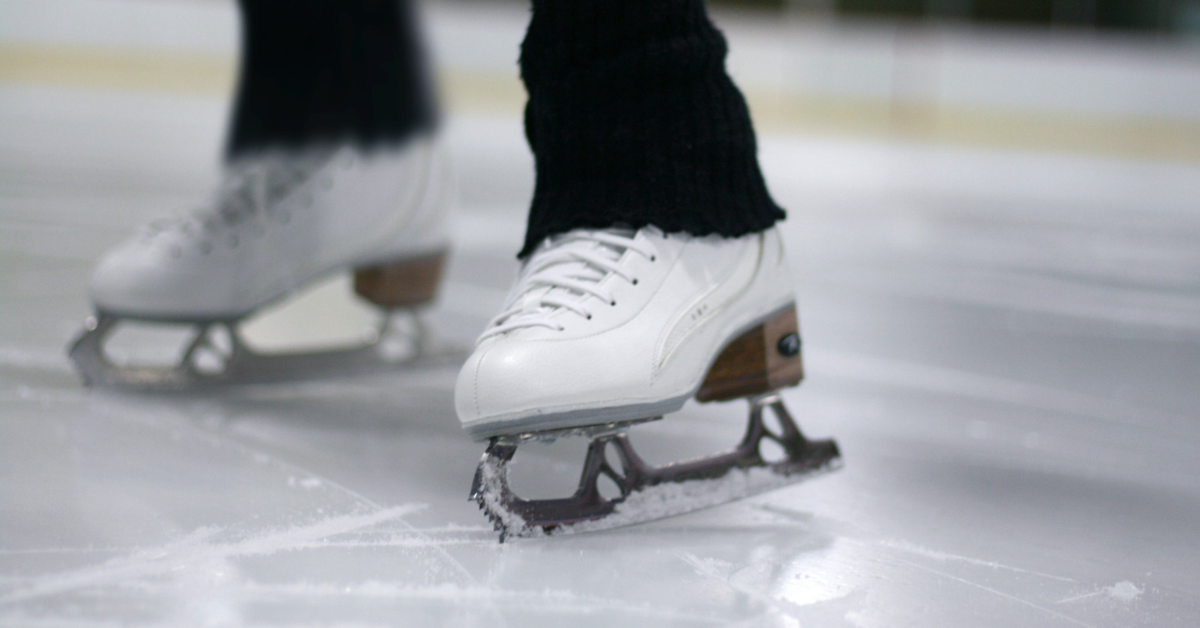A Simple Guide to Stopping on Ice Skates

Sure, ice skating looks like a breeze when you watch movies or the Olympics. But those first few outings on a pond or a rink can be treacherous for beginner skaters, especially if they don’t yet have the mechanics down. For some, even stopping on ice skates looks easier than it is.
Over the years, we’ve provided tips and techniques for beginners and competitive skaters alike. This post will cover the different types of stops as well as some additional tips all skaters may appreciate.
What Are the Different Types of Ice Skating Stops?
There are three main ice skating stopping techniques: the snowplow stop, the hockey stop, and the T-stop.
Stop Technique #1: Snowplow Stop
Known as a simple way to stop, the snowplow stop gets its name from the position of the foot as it plows forward at an angle.
To perform a snowplow stop, you’ll start by pointing your toes inward and heels outward into an upside-down V shape that will slow your skating speed. This is similar to the pizza shape often referenced in downhill skiing snowplow stops.
You’ll want to bend your knees enough to keep balance and ensure that the angle of your feet creates enough resistance on the surface of the ice to bring you to a stop.
You may also use the snowplow method with one foot rather than two, but we recommend you use both feet until you’re comfortable with your stopping.
Stop Technique #2: Hockey Stop
Skaters with a little more stopping experience may use this stop. In Basic 5, for figure skating levels, skaters will learn how to make the hockey stop.
The hockey stop is a preferred method for stopping when skating at higher speeds. As you may have already guessed, the hockey stop is known most for being used by hockey players.
To perform the hockey stop, bend your knees into a slight crouch and then turn your skates sideways at an angle. Both feet should be pointing the same direction. It is helpful to keep your shoulders and upper body facing forward as your knees and toes turn to the side.
Expert Skating Tip: Think 2:30 on an analog clock, not quite 3:00 or 90 degrees.
Lean your body away from the direction of your skates as you plant the blades into the ice, creating friction until you come to a halt.
Ironically, the hockey stop is also commonly used as a figure skating stop. So, if you’re an intermediate skater practicing your stop on figure skates, you may want to utilize either the snow plow or hockey stop.
Expert Skating Tip: Skaters typically use the hockey stop at higher speeds, but that does not mean the method is perfect. Beginners and intermediate skaters should avoid high speeds for safety’s sake.
Stop Technique #3: T-Stop
Like the hockey stop, the T-stop is a more advanced stop and should not be performed by first-time skaters.
To perform the T-stop, start by forming a T with your feet as you glide (though they shouldn’t yet be touching). Your hips should be at a slight angle while your shoulders face forward and parallel with the forward-facing gliding foot.
Gliding in this position, you’ll stop by bending your knees and pulling your stopping leg into the back of the gliding foot (forming the T). Lean back slightly to the outside edge on the stopping leg.
Expert Skating Tip: The back foot will bear the brunt of the stop, so you’ll want to use your dominant foot as your back foot.
What Is the Easiest Stop in Ice Skating?
The snowplow stop is known as the easiest stop technique in ice skating. Since it doesn’t require sharp turns or complex edge control, it’s perfect for beginners learning to stop safely.
Stopping on Ice: X-factors for Your Technique
A couple of primary factors can influence your ability to perform these techniques. These include ice conditions, balance, and edge control.
Conditions
Ice conditions significantly impact stopping ability. On freshly resurfaced ice, skates may slide more easily due to the slick surface. Conversely, rough or snow-covered ice can create unpredictable resistance, making it harder to execute a controlled stop.
You should practice techniques like the hockey stop and snowplow stop while adapting to different ice conditions. With time and experience, you can develop the skills needed to stop quickly and safely, even in challenging situations.
Balance
Balance also plays a critical role in executing a proper stop. Skaters should distribute their weight evenly and maintain stability while shifting their skates into a stopping position. If you lean too far forward or backward, you risk falling or losing control. Having good knee bend is another important component of keeping your balance through a stop.
Edge Control
Finally, edge control is essential for stopping efficiently. Skaters should use the inside or outside edges of their blades to create friction against the ice. If you don’t apply the right amount of pressure or angle their skates correctly, you may skid uncontrollably instead of coming to a smooth stop, or conversely, catch the edge of the blade in the ice if using too much pressure.
Final Tip: Footwork Matters
Your footwork is key when attempting to stop on ice skates. Good footwork will help you maintain edge control and balance, and precise foot movements will create the necessary friction to slow down smoothly.
With consistent practice, you can refine your footwork to stop quickly and confidently in any situation. Visit our blog post on mastering footwork to learn more.
